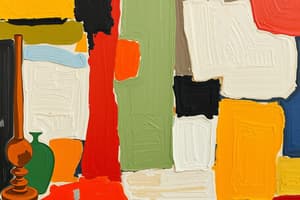Podcast
Questions and Answers
Which artist is known for leading the way in the use of realism in painting during the Renaissance?
Which artist is known for leading the way in the use of realism in painting during the Renaissance?
- Raphael Sanzio
- Giotto (correct)
- Donatello
- Piero della Francesca
What significant advance in painting was pioneered by Piero della Francesca and Andrea Mantegna?
What significant advance in painting was pioneered by Piero della Francesca and Andrea Mantegna?
- Religious themes
- Linear perspective (correct)
- Use of oil-based paints
- Portrait realism
Which characteristic distinguishes northern European art from that of Italy during the Renaissance?
Which characteristic distinguishes northern European art from that of Italy during the Renaissance?
- Development of mannerism
- More religious orientation (correct)
- Use of classical figures
- Focus on human ideals
What style did Titian and other sixteenth-century painters develop that involved the distortion of figures and heightened color?
What style did Titian and other sixteenth-century painters develop that involved the distortion of figures and heightened color?
Which statement about Renaissance artists and their training is accurate?
Which statement about Renaissance artists and their training is accurate?
What aspect of Michelangelo's work contributed to his international renown?
What aspect of Michelangelo's work contributed to his international renown?
Who was one of the first artists to successfully use oil-based paints?
Who was one of the first artists to successfully use oil-based paints?
What transition occurred in the early sixteenth century regarding the center of Renaissance art?
What transition occurred in the early sixteenth century regarding the center of Renaissance art?
What motivated wealthy patrons to commission works of art during the Renaissance?
What motivated wealthy patrons to commission works of art during the Renaissance?
Which of the following statements best describes Pope Julius II's involvement with Michelangelo's work?
Which of the following statements best describes Pope Julius II's involvement with Michelangelo's work?
What role did personal wealth play in the development of urban elite culture during the Renaissance?
What role did personal wealth play in the development of urban elite culture during the Renaissance?
What was a significant change in the themes of Renaissance art as humanist ideas spread?
What was a significant change in the themes of Renaissance art as humanist ideas spread?
How did the private chapel fit into the lives of the wealthy during the sixteenth century?
How did the private chapel fit into the lives of the wealthy during the sixteenth century?
What was a change in spending priorities among the nobles during the Renaissance?
What was a change in spending priorities among the nobles during the Renaissance?
Which aspect of Renaissance patronage is reflected in the way patrons interacted with artists?
Which aspect of Renaissance patronage is reflected in the way patrons interacted with artists?
What did many wealthy patrons utilize as a display of their wealth in their residences?
What did many wealthy patrons utilize as a display of their wealth in their residences?
Flashcards are hidden until you start studying
Study Notes
Patronage and Power
- The Renaissance witnessed remarkable creativity in painting, architecture, and sculpture during the 1400s and 1500s.
- Wealthy urban groups in early Renaissance Italy often commissioned art to showcase their affluence.
- By the late 15th century, individual wealthy patrons, including merchants and popes, began sponsoring art to elevate their prestige.
- Patrons varied in engagement level; some simply requested artwork, while others closely monitored progress and offered input.
- Pope Julius II actively influenced Michelangelo's work on the Sistine Chapel ceiling by frequently providing suggestions during its creation.
- Changes in spending behavior among elites reflected a shift from military expenses to artistic investments, as urban culture took precedence.
- Grand urban palaces and private chapels became significant status symbols for the newly affluent in the 16th century.
- Chapels served as both a religious center and a site for commemorating deceased family members.
Changing Artistic Styles
- Religious subjects dominated Renaissance art, often featuring patrons and their families in key scenes.
- Humanist ideas led to the integration of classical themes, depicting pagan deities alongside religious imagery.
- Individual portraiture emerged as a prominent genre, emphasizing realism and human ideals.
- Giotto was instrumental in advancing realism, particularly through his natural depictions of human bodies and faces.
- Piero della Francesca and Andrea Mantegna contributed to the development of perspective, enhancing spatial representation in painting.
- Donatello revived classical sculpture, focusing on balance and self-awareness in figures.
- Filippo Brunelleschi's architectural designs were inspired by classical forms, achieving harmony and balance.
- Northern European art maintained a strong religious focus, contrasting with Italian works.
- Flemish painters, including Rogier van der Weyden and Jan van Eyck, achieved equal status with Italian contemporaries by using oil-based paints effectively.
- Albrecht Dürer became renowned for his detailed representations of the human form and the natural world, as well as innovations in perspective tools.
- The art center shifted from Florence to Rome in the early 16th century, supported by extensive patronage from Renaissance popes.
- Michelangelo’s projects in Rome, including the Pietà and Sistine Chapel ceiling, gained him international fame.
- Raphael Sanzio gained popularity across Europe, emphasizing nature imitation and design principles in his artworks.
- The emergence of mannerism as an artistic style featured exaggerated figures and vibrant colors to convey heightened emotions.
The Renaissance Artist
- Some artists were richly rewarded by patrons, and a few gained the status of "genius."
- Renaissance thinkers viewed artwork as a manifestation of an individual artist's unique vision, transcending traditional techniques.
- Michelangelo and Leonardo da Vinci epitomized the new archetype of the Renaissance artist as a genius.
- Despite their perceived genius, artists were expected to receive formal training, typically through apprenticeships under established artists to master techniques and conventions.
Studying That Suits You
Use AI to generate personalized quizzes and flashcards to suit your learning preferences.




